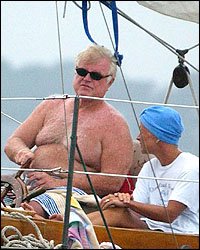You Mean There was a Case that Didn't Involve a Former Stripper Today Too?
The dispute arose out of Vermont's landmark 1997 campaign finance law, which included a $300,000 spending cap for gubernatorial candidates and lesser limits for other state political contests. Contributions to state campaigns were limited to as little as $200 per election cycle for state House races.The spending limits issue hasn't had much movement since Buckley v Valeo in 1976. There the Court said that contributions could be limited, but campaign spending could not. Buckley is a huge obstacle to get beyond, and it was brought up in oral argument...
Justice Breyer commented: "There is a case -- Buckley [v. Valeo] -- that says that expenditure limits are not constitutional. Am I not bound by that? Why am I not bound by that, whether I may not agree with it?" He put the question to Brenda Wright, representing the Vermont Public Interest Research Group. She insisted -- but did not appear to be convincing in doing so -- that the record in the Buckley case did not really test that issue.Ms. Wright can insist all she wants, but she's got to come up with something to distinguish Buckley from this case. There is a strong presumption in favor of campaign expenditures being seen as speech, and therefore being highly protected. You can try to distinguish Buckley in the following ways: state that the Buckley test has never been held only state law (it dealt with a federal law), claim that the issue was never fully examined (which seems weak, since the Court stated it outright as if it was a "well, duh" legal fact), or argue on public policy grounds (that these limits would stop politicians from constant fundraising and make them work on the business of the people). Personally, I think those arguments are pretty crappy. I don't think the Court is going anywhere on that aspect of Buckley.
The real battle is in the contribution limitations. Contributions have been fair game for regulation and limitation under the Court's campaign jurisprudence for a long time. The real issue here is summed up again by the always gabby Justice Breyer...
"At what point does a limit become so low that you cuff off the possibility of a challenge?"The $200 per election cycle limit for state House races and the $400 per two-year election cycle limit for governors' races is really, really low. I'd go as far as to call it shockingly low. The justices, as Breyer says, are concerned that the limits may be so low that they will cut off any chance of a challenger defeating an incumbent.
In oral argument, Vermont's Attorney General William B. Sorrell tried to portray the state as being overrun with corruption and dirty money. The limits were necessary to reduce the political knavery that was running rampant in the Green Mountain State. Chief Justice Roberts decided to probe this...
Chief Justice John G. Roberts, Jr., asked Sorrell very early: "How many prosecutions have you had for political corruption in Vermont?" (None, was the answer.) And then: "Is political corruption a problem in Vermont?" (70 percent of the citizens think so.) And then: "Would you describe your state as clean or corrupt?" (No one has gone to jail, but "the threat of corruption in Vermont is far from illusory.")Protecting against the appearance of corruption has been deemed a legitimate state interest in the past. This exchange may show that the Chief is skeptical of that, especially in a case where the contribution limits are so low.
Campaign finance law is one of my areas of interest, so I'll be eagerly awaiting the opinion in this case. I'm hoping that a full transcript of the oral arguments will be available soon, so I can read the tea leaves of the justices' questions and figure out their leanings.





